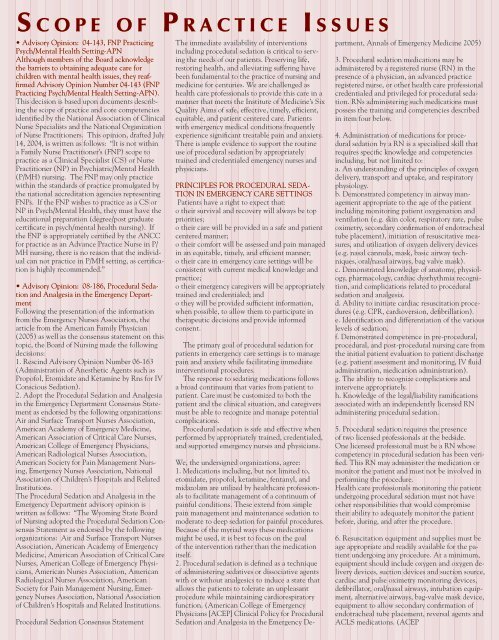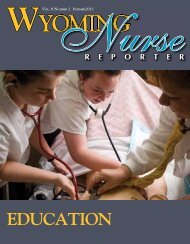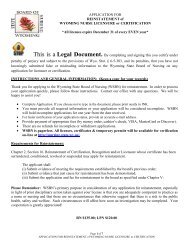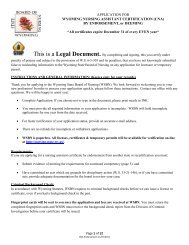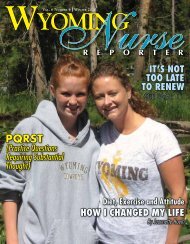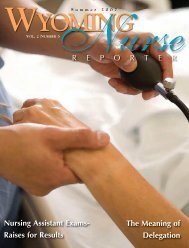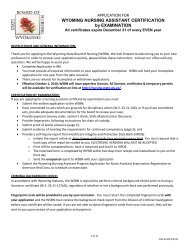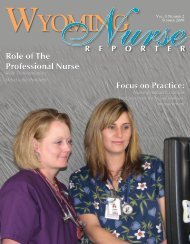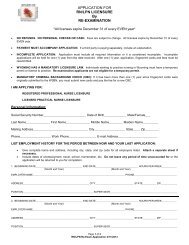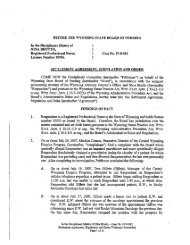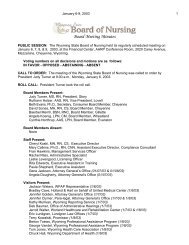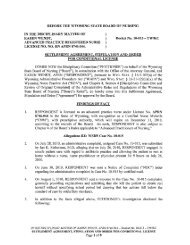Nurse Reporter Fall 2008 - Wyoming State Board of Nursing
Nurse Reporter Fall 2008 - Wyoming State Board of Nursing
Nurse Reporter Fall 2008 - Wyoming State Board of Nursing
You also want an ePaper? Increase the reach of your titles
YUMPU automatically turns print PDFs into web optimized ePapers that Google loves.
S c o p e o f Pr a c t i c e Is s u e s• Advisory Opinion: 04-143, FNP PracticingPsych/Mental Health Setting-APNAlthough members <strong>of</strong> the <strong>Board</strong> acknowledgethe barriers to obtaining adequate care forchildren with mental health issues, they reaffirmedAdvisory Opinion Number 04-143 (FNPPracticing Psych/Mental Health Setting-APN).This decision is based upon documents describingthe scope <strong>of</strong> practice and core competenciesidentified by the National Association <strong>of</strong> Clinical<strong>Nurse</strong> Specialists and the National Organization<strong>of</strong> <strong>Nurse</strong> Practitioners. This opinion, drafted July14, 2004, is written as follows: “It is not withina Family <strong>Nurse</strong> Practitioner’s (FNP) scope topractice as a Clinical Specialist (CS) or <strong>Nurse</strong>Practitioner (NP) in Psychiatric/Mental Health(P/MH) nursing. The FNP may only practicewithin the standards <strong>of</strong> practice promulgated bythe national accreditation agencies representingFNPs. If the FNP wishes to practice as a CS orNP in Psych/Mental Health, they must have theeducational preparation (degree/post graduatecertificate in psych/mental health nursing). Ifthe FNP is appropriately certified by the ANCCfor practice as an Advance Practice <strong>Nurse</strong> in P/MH nursing, there is no reason that the individualcan not practice in P/MH setting, as certificationis highly recommended.”• Advisory Opinion: 08-186, Procedural Sedationand Analgesia in the Emergency DepartmentFollowing the presentation <strong>of</strong> the informationfrom the Emergency <strong>Nurse</strong>s Association, thearticle from the American Family Physician(2005) as well as the consensus statement on thistopic, the <strong>Board</strong> <strong>of</strong> <strong>Nursing</strong> made the followingdecisions:1. Rescind Advisory Opinion Number 06-163(Administration <strong>of</strong> Anesthetic Agents such asProp<strong>of</strong>ol, Etomidate and Ketamine by Rns for IVConscious Sedation).2. Adopt the Procedural Sedation and Analgesiain the Emergency Department Consensus <strong>State</strong>mentas endorsed by the following organizations:Air and Surface Transport <strong>Nurse</strong>s Association,American Academy <strong>of</strong> Emergency Medicine,American Association <strong>of</strong> Critical Care <strong>Nurse</strong>s,American College <strong>of</strong> Emergency Physicians,American Radiological <strong>Nurse</strong>s Association,American Society for Pain Management <strong>Nursing</strong>,Emergency <strong>Nurse</strong>s Association, NationalAssociation <strong>of</strong> Children’s Hospitals and RelatedInstitutions.The Procedural Sedation and Analgesia in theEmergency Department advisory opinion iswritten as follows: “The <strong>Wyoming</strong> <strong>State</strong> <strong>Board</strong><strong>of</strong> <strong>Nursing</strong> adopted the Procedural Sedation Consensus<strong>State</strong>ment as endorsed by the followingorganizations: Air and Surface Transport <strong>Nurse</strong>sAssociation, American Academy <strong>of</strong> EmergencyMedicine, American Association <strong>of</strong> Critical Care<strong>Nurse</strong>s, American College <strong>of</strong> Emergency Physicians,American <strong>Nurse</strong>s Association, AmericanRadiological <strong>Nurse</strong>s Association, AmericanSociety for Pain Management <strong>Nursing</strong>, Emergency<strong>Nurse</strong>s Association, National Association<strong>of</strong> Children’s Hospitals and Related Institutions.Procedural Sedation Consensus <strong>State</strong>mentThe immediate availability <strong>of</strong> interventionsincluding procedural sedation is critical to servingthe needs <strong>of</strong> our patients. Preserving life,restoring health, and alleviating suffering havebeen fundamental to the practice <strong>of</strong> nursing andmedicine for centuries. We are challenged ashealth care pr<strong>of</strong>essionals to provide this care in amanner that meets the Institute <strong>of</strong> Medicine’s SixQuality Aims <strong>of</strong> safe, effective, timely, efficient,equitable, and patient centered care. Patientswith emergency medical conditions frequentlyexperience significant treatable pain and anxiety.There is ample evidence to support the routineuse <strong>of</strong> procedural sedation by appropriatelytrained and credentialed emergency nurses andphysicians.PRINCIPLES FOR PROCEDURAL SEDA-TION IN EMERGENCY CARE SETTINGS➢Patients have a right to expect that:o their survival and recovery will always be toppriorities;o their care will be provided in a safe and patientcentered manner;o their comfort will be assessed and pain managedin an equitable, timely, and efficient manner;o their care in emergency care settings will beconsistent with current medical knowledge andpractice;o their emergency caregivers will be appropriatelytrained and credentialed; ando they will be provided sufficient information,when possible, to allow them to participate intherapeutic decisions and provide informedconsent.➢ The primary goal <strong>of</strong> procedural sedation forpatients in emergency care settings is to managepain and anxiety while facilitating immediateinterventional procedures.➢ The response to sedating medications followsa broad continuum that varies from patient topatient. Care must be customized to both thepatient and the clinical situation, and caregiversmust be able to recognize and manage potentialcomplications.➢ Procedural sedation is safe and effective whenperformed by appropriately trained, credentialed,and supported emergency nurses and physicians.We, the undersigned organizations, agree:1. Medications including, but not limited to,etomidate, prop<strong>of</strong>ol, ketamine, fentanyl, andmidazolam are utilized by healthcare pr<strong>of</strong>essionalsto facilitate management <strong>of</strong> a continuum <strong>of</strong>painful conditions. These extend from simplepain management and maintenance sedation tomoderate to deep sedation for painful procedures.Because <strong>of</strong> the myriad ways these medicationsmight be used, it is best to focus on the goal<strong>of</strong> the intervention rather than the medicationitself.2. Procedural sedation is defined as a technique<strong>of</strong> administering sedatives or dissociative agentswith or without analgesics to induce a state thatallows the patients to tolerate an unpleasantprocedure while maintaining cardiorespiratoryfunction. (American College <strong>of</strong> EmergencyPhysicians [ACEP] Clinical Policy for ProceduralSedation and Analgesia in the Emergency Department,Annals <strong>of</strong> Emergency Medicine 2005)3. Procedural sedation medications may beadministered by a registered nurse (RN) in thepresence <strong>of</strong> a physician, an advanced practiceregistered nurse, or other health care pr<strong>of</strong>essionalcredentialed and privileged for procedural sedation.RNs administering such medications mustpossess the training and competencies describedin item four below.4. Administration <strong>of</strong> medications for proceduralsedation by a RN is a specialized skill thatrequires specific knowledge and competenciesincluding, but not limited to:a. An understanding <strong>of</strong> the principles <strong>of</strong> oxygendelivery, transport and uptake, and respiratoryphysiology.b. Demonstrated competency in airway managementappropriate to the age <strong>of</strong> the patientincluding monitoring patient oxygenation andventilation (e.g. skin color, respiratory rate, pulseoximetry, secondary confirmation <strong>of</strong> endotrachealtube placement), initiation <strong>of</strong> resuscitative measures,and utilization <strong>of</strong> oxygen delivery devices(e.g. nasal cannula, mask, basic airway techniques,oral/nasal airways, bag valve mask).c. Demonstrated knowledge <strong>of</strong> anatomy, physiology,pharmacology, cardiac dysrhythmia recognition,and complications related to proceduralsedation and analgesia.d. Ability to initiate cardiac resuscitation procedures(e.g. CPR, cardioversion, defibrillation).e. Identification and differentiation <strong>of</strong> the variouslevels <strong>of</strong> sedation.f. Demonstrated competence in pre-procedural,procedural, and post-procedural nursing care fromthe initial patient evaluation to patient discharge(e.g. patient assessment and monitoring, IV fluidadministration, medication administration).g. The ability to recognize complications andintervene appropriately.h. Knowledge <strong>of</strong> the legal/liability ramificationsassociated with an independently licensed RNadministering procedural sedation.5. Procedural sedation requires the presence<strong>of</strong> two licensed pr<strong>of</strong>essionals at the bedside.One licensed pr<strong>of</strong>essional must be a RN whosecompetency in procedural sedation has been verified.This RN may administer the medication ormonitor the patient and must not be involved inperforming the procedure.Health care pr<strong>of</strong>essionals monitoring the patientundergoing procedural sedation must not haveother responsibilities that would compromisetheir ability to adequately monitor the patientbefore, during, and after the procedure.6. Resuscitation equipment and supplies must beage appropriate and readily available for the patientundergoing any procedure. At a minimum,equipment should include oxygen and oxygen deliverydevices, suction devices and suction source,cardiac and pulse oximetry monitoring devices,defibrillator, oral/nasal airways, intubation equipment,alternative airways, bag-valve mask device,equipment to allow secondary confirmation <strong>of</strong>endotracheal tube placement, reversal agents andACLS medications. (ACEP


